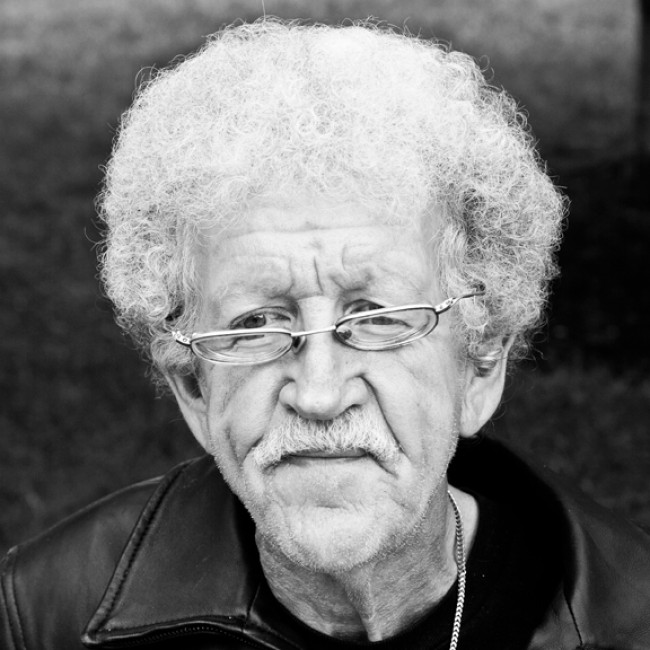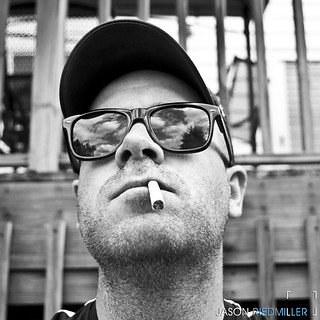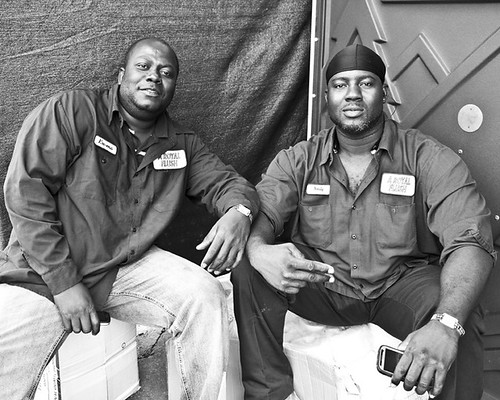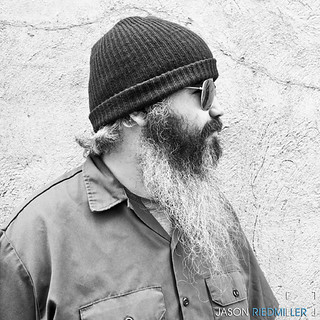Scranton photographer stops random subjects for ‘Street Portraits’

Jason Riedmiller’s direct personality reflected in his straightforward, spur-of-the-moment work at The Bog this month
Those who know Scranton photographer Jason Riedmiller recognize his penchant for blunt honesty and sarcasm. Now they’ll see the former in his portrait work – the latter is evident when you ask him about it.
“I’ve always been kind of an arrogant dick. I’m not a learner,” he cracks when NEPA Scene inquires about any teachers or influences he may have had in his early days taking photos.
“I like to take the helmet off and just dive into shit and learn that way.”
That’s his inimitable way of saying that he’s always done things his own way, learning his craft on the fly. His fascination with photography came as early as he can remember and simply never left.
“I started stealing my mom’s point-and-shoots at parties and taking pictures of family members and the dogs and what have you. Then I started sneaking them out of the house when I was in like seventh and eighth grade and in high school,” Riedmiller remembered.
“I just always did it, and when I realized in my freshman year of college how much I hated being an English major, it dawned upon me that I could actually just be a photographer, which is what I always loved to do anyway.”
After a few tries at college, the Scranton native knew he didn’t want to deliver auto parts for the rest of his life, “knowing nothing about auto parts, still to this day,” so he went back to school at Penn State University and majored in photography, where he learned the technical end of things while maintaining his natural artistic style.
 |
“As I had been taking pictures for 10 to 12 years before I went to school, I had no idea how to develop a negative or make a print. I just shot and shot and shot and took the stuff to CVS or Walmart and waited for my stuff to come back, which was an excruciating hour to an hour and a half,” he noted.
“I just found a whole bunch of them the other day, too. Some of the best pictures I ever took were pictures I took when I was in high school on point-and-shoot cameras. There was a joy in the ignorance of not actually knowing what I was doing. It’s really all gone downhill since I learned.”
Obviously, he has a much different definition of “downhill” than most, earning two Keystone Press Awards for his dynamic sports and concert photos in local newspapers, establishing his own photography business, and becoming the photo editor of the successful local music blog Highway 81 Revisited.
At 38, Riedmiller has displayed his photos in many standard and unconventional ways throughout Northeastern Pennsylvania over the years, but his latest exhibit, “Street Portraits,” which opens Nov. 7 at The Bog during the First Friday art walk in downtown Scranton, could be his best work yet, not just because of its content, but because it genuinely captures his subjects’ personalities as much as his own behind the lens.
People are people
This will mark the first time since 2007 that Riedmiller has put together a month-long show, an exhibit that was also at The Bog and started the popular bar’s art wall. While this one has some similarities, the biggest difference is his approach to photography.
“I used to do things very posed. I would set it up the way I wanted it, very much my influence on the images, and the first show was photos of friends, local musicians, just people that I found interesting, but it was much more of a studio setting. It was all very dictated by me as to how things were going to look,” he admitted.
“This is similar in the subject matter, but the difference is that it’s no longer dictated by me how these things are going to look. I let the subject be themselves and just try to capture them as who they are, which I really like. … It’s just very spur of the moment, off-the-cuff, this is the person, this is the situation, boom, it’s done. Very few of these portraits I took were more than four or five frames. These are portrait sessions that are lasting 15 seconds to get these images, whereas before these were lasting two hours and 15 rolls of film.”
The “Street Portraits” are mostly of complete strangers, ranging from celebrities like Rob Zombie, who he met backstage while shooting the 2013 Rockstar Energy Drink Mayhem Festival, to “that dude that looks like Kurt Vonnegut that’s always walking around the square.”
“It’s just people. I wasn’t going to include the celebrity photos; then I realized I really liked a whole bunch of them. I also realized I didn’t want to put up that wall of it’s either random people or famous people. It’s just people, regardless of their place in life, their status, their celebrity. They’re just people I found interesting and wanted to take their photo, which, much to the chagrin of every art teacher I’ve ever had, that is really why I do it,” he emphasized.
“I just see interesting people and I really want to take their photo. That could be deep on its own level, but I prefer to think it’s not.”
Faces in the crowd
Riedmiller tends to keep things simple and direct, though this candor can be mistaken for confidence that actually doesn’t come as easily as one would assume. He can’t quite pinpoint exactly what is so interesting about one face over another, but he must act quickly if he spots a potential subject.
“It’s a very individual thing with each person. Usually, I’ll go out and be asking people to take their photo, and sometimes people will ask me to take their photo, and that makes me mad for some reason. I don’t know why; I want it to be more difficult for me because I don’t like walking up to people and asking to take a stranger’s photo. Actually, it takes a lot for me to do it.”
That’s not the only way he stands out from other photographers. While covering The Governors Ball Music Festival in New York, he listened to his fellow photogs complain about not getting into the pit soon enough, bad lighting, and only receiving free tequila on the first day. He told them not to bitch, pointing out that sanitation workers had to clean toilets and garbage while these privileged few pursued their passion, but he was ignored, prompting him to take his favorite photos of the weekend.
“On the last day, I actually found those people cleaning up shit, so I was like, ‘So, how are you guys enjoying the weekend?’ They were having a much better time. They’re like, ‘Free music! We’re getting paid to be here! There’s all these pretty girls!’ So I was like, ‘I need to take your portrait,’” Riedmiller recalled, his heart of gold shining through for just a moment.
“I think I might actually stick that story under their photo because people are going to find it really strange that there’s two men in Royal Flush coveralls with poop on them sitting next to a Port ‘O’ Jonny in my show.”
 |
Sticking with Canon cameras since his brother gave him his first SLR that he brought back from Iraq after serving in the first Gulf War, Riedmiller also takes issue with photographers, artists, and critics who feel that digital photography is inferior to film, frankly feeling bored by the debate.
“It’s like arguing whether you like acoustic or electric guitar more – it’s just dumb,” he compared.
“They both serve a very good purpose at the right time. The way our society is right now – analog film is a hobby thing now. That would be like when I was in college if people were showing up with tintypes and glass plates and being like, ‘No, man, this whole 35mm stuff is bullshit. You’re not a real photographer unless you’re using tintypes!’ And people still say that, especially in the fine art community. They’re like, ‘Oh, well it can’t be art if you’re using a digital camera.’ OK, well that’s a completely subjective and stupid statement, but it’s art, so have blast! I will continue to not care about you.”
It’s the subject matter that he truly cares about.
“It’s like a record and a CD – the digital does kill it a little bit, but not enough, in my opinion, to make it a bad thing. I actually kind of like it, especially with the photos I’m doing now just walking around the street, finding interesting people or sometimes intentionally photographing people I wouldn’t want to photograph just to prove a point to myself, and that point being is that I’m not an asshole, even though I kind of am.”
Rarely missing an opportunity to be self-deprecating, at first he was “extremely opposed” to using Instagram, the app that suddenly made everyone with a phone a “professional” photographer, but then he remembered his own argument that equipment didn’t matter.
“As a photographer, I should be able to make good images on a phone with Instagram or my whole point about equipment not being important is completely invalid. I started doing it as a joke and then I wound up doing a guerrilla show,” he explained, accentuating the fact that he couldn’t explain exactly where it was, other than it being posted on a graffitied building, due to the shaky legality of the presentation, which lasted a weekend before being torn down.
“There was an illegal show somewhere in Scranton, Pennsylvania with portraits I took on my phone. I was not involved in any way,” he joked.
“It was awesome. All these little 4 x 4 headshots of just everybody I encountered over about a three-month period. Every single one of them was like, ‘Why do you want to take my picture?’ Because I just fuckin’ do. It’s what I do!”
Documenting presence
His work was also, with permission this time, projected onto a wall during Arts on the Square in downtown Scranton, so for “Street Portraits,” he simply can’t stick to traditional frames, mounting each photo on wood or bamboo.
“This show is definitely influenced greatly by everything I’ve done from an artistic standpoint, and my portrait work has been very much influenced by that guerrilla show I did. I’m fascinated with the square shape, just people’s heads, right down to the nitty-gritty, trying to get the essence of the subject,” he pointed out.
“I never learned composition – that was just there. It was inherent in me. I’ve always seen the world this way, and I’ve always been capturing it like that. I never learned that.”
 |
That doesn’t mean you can’t teach a pro photographer new tricks, or at the very least, the history of his own profession.
“Here’s what a phenomenally poorly educated photographer I am – I learned about August Sander maybe three years ago from my friend Nina Muto because she said some of my stuff that I was doing reminded her of August Sander. I was like, ‘OK, who’s August Sander?’ She’s like, ‘You’re an idiot.’ August Sander, probably the most influential portrait photographer of the 20th century, was a German, and he just went around with his giant 8 x 10 camera photographing people around Germany,” he acknowledged.
“He did take commissions too to make money, but even his commission work was just so bizarre and strange, just the way that he looked at the world. It was very in the moment, but you could tell that he was definitely influencing the photos to be his style, which is something I hope to develop. I hope to combine those two things.”
Thankfully, both friends and strangers continue to be willing to pose, even for just a moment, for photos they’ll likely never see unless they wander into The Bog this month and notice a collection of random faces assembled by a man who, inexplicably, feels compelled to place them there.
“Most people are totally fine with it. I rarely, rarely have somebody say no. People tend to be very curious as to why you want their picture and you might need to explain it a little, and a lot of people are just like, ‘Sure. Go ahead,’” Riedmiller said.
“When I went to college, I wanted to be a fashion magazine photographer, and man, I don’t want that anymore. I don’t even want to make money doing pictures anymore. I still do, obviously. As far as my portraits go, I just do it because I have to.
“I’m very pleased with the way I’ve let go of having control over things and have just really started documenting the subjects. I try not to have even really a feeling on them. I almost don’t want to know their story because I don’t want to be biased in any way. I just want to be documenting their presence, the way they put themselves out there in the world, without knowing anything about them.”
Location: The Bog (341 Adams Ave., Scranton)
Date: Opening reception Friday, Nov. 7, on display all month long
Time: 6 p.m.
Cost: Free
by Rich Howells
Rich is an award-winning journalist, longtime blogger, photographer, and podcast host. He is the founder and editor of NEPA Scene.



